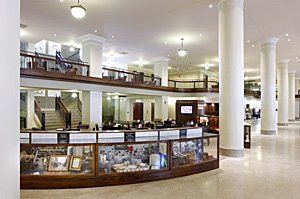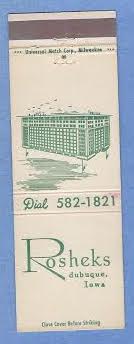Encyclopedia Dubuque
"Encyclopedia Dubuque is the online authority for all things Dubuque, written by the people who know the city best.”
Marshall Cohen—researcher and producer, CNN
Affiliated with the Local History Network of the State Historical Society of Iowa, and the Iowa Museum Association.
ROSHEK'S DEPARTMENT STORE


ROSHEK'S DEPARTMENT STORE. Roshek's was once Iowa's largest department store. In 1893 John J. ROSHEK,a buyer for Siegel and Cooper of Chicago; his brother Frank H. Roshek, a traveling salesman for a Philadelphia wholesale house; and A.E. Rubash, a dress good buyer for Denneck Yetter of Cedar Rapids, established a dry goods business in Dubuque. The Roshek, Rubash & Company was located in the Horr Building at 556 Main. Rubash sold out and a Mr. Aimann joined the business. On April 6, 1896 the firm's name became ROSHEK, AIMAN AND COMPANY.
Mr. Aimann sold out around 1900 and the Roshek Brothers Dry Goods firm and later Roshek Brothers Company was established. A store was constructed at the corner of 8th and Main. The land was purchased from William L. BRADLEY, Sr. (1)
On February 12, 1929, J. J. Roshek announced that land for a new department store had been obtained from the ARCHDIOCESE OF DUBUQUE. Roshek Realty Company held the title to the Levi store property on the southeast corner of 7th and Main STREETS. The title for this piece of property was exchanged with the Archdiocese to obtain land at the southeast corner of 8th and Locust. Charles Wheeler Nicol, a Chicago architect, was chosen to design what became Iowa's largest department store. W. L. Yokum, builder of the Dubuque Masonic Temple at 12th and Locust, was chosen as the contractor. (2)
On August 12, 1929 construction began on the northern half of the store. Merchandise was stored and business conducted from the Rider-Wallis store to the south. The northern half of the building was ready on June 28, 1930 and the merchandise was moved. On July 7, 1930 demolition began on the Rider-Wallis building. Construction on the southern half of the new building continued through the spring of 1931. As the two halves were being joined, Roshek's offered its "Removal Sale." Merchandise from the northern half of the building was placed on clearance sale. (3) In 1933 Roshek's advertised that it had pioneered the "bargain basement" concept. (4)
The Telegraph-Herald and Times-Journal listed among other facts of the building: (5)
a) the construction of one-half and then the other
was so unique that only the Palmer House (hotel)
and Boston Store in Chicago were the only known
predecessors
b) the settling of the first half had to be determined
and allowance made in the elevation of floors in the
second section
c) the average payroll per week during construction was
$3,674.00
d) the cost of materials each week was $4,790.16
e) the use of small show windows and neutral backgrounds
to emphasize the merchandise displayed was virtually
unknown in buildings of this type.
On July 7, 1931 Roshek's opened its Grille and Soda Fountain in the basement on the 7th Street side. The grill and soda fountain were designed in four U-shaped bays and could accommodate nearly one hundred who were treated to the sight of a soda bar more than 75 feet long, counter tops of marble, and a separate pastry department. (6) John J. ROSHEK had his private office on the fourth floor. When the store opened, the temporary office of F. H. Roshek was on the fifth floor although his permanent offices were in New York City were he conducted buying for the business. (7) In 1931 the 9th and top floors remained unfinished, but they were to open as a restaurant and tearoom.
A unique use of a department store was made in 1932. "The Man of Galilee," part of a private collection loaned to the Roshek company, was exhibited on the fifth floor for one week in July. The 7' x 9' canvass was painted by Carl Thomtay in Copenhagen, Denmark in 1900 and was valued at $70,000. No admission was charged to see the masterpiece which was lighted by special lighting effects and setting designed by the owner of the painting. (8)

The building representing a $1.5 million investment for Rosheks offered six floors of retail space, mezzanine, basement, three floors of offices, sub-basement, and storage space. Customers were serviced by six elevators with white-gloved attendants. An article in the Telegraph Herald in 2009 mentioned special "Roshek trains" that brought shoppers into Dubuque from surrounding communities at Christmas for shopping. Children stood amazed at the outside windows which featured moving figures of Santa, his elves, and the reindeer.
One of the lesser known stories involving Roskek's was the role of Arthur G. STEN, the "display" man at the store. In one year, his work entered in the contests sponsored by the International Association of Display Men won fourteen prizes. He was also the first man to win a championship medal for original work submitted in the contests. Winning meant that he could not complete again for three years.
Family ties to the company ended in 1964 when the firm was sold to the Chicago mail-order house, Aldens. The store left became known as the DUBUQUE BUILDING in May 1968.
Aldens merged with Gamble Skogmo,Inc. the same year. In 1980 Gamble-Skogmo was purchased by Wickes. Somewhere during those years the apostrophe in Roshek's was dropped in the store name.
Wickes' financial difficulties led to the company selling off its department stores including Rosheks. In 1982 Rosheks was purchased by ARMSTRONG'S DEPARTMENT STORE, the giant Cedar Rapids clothing store. Ironically, when S. G. Armstrong was just beginning his own operation in Cedar Rapids, one of his original staff was John Roshek who four years later started his own Dubuque store.
Armstrong's announced its intention to increase the business volume at the Rosheks store by 50 percent in three years. In 1989-90 Armstrong's, a powerful marketing draw, joined with other Mall merchants in massive renovation activities at Kennedy Mall. In late 1990, however, the financial collapse of the Cedar Rapids operation led to the announcement that the Dubuque store, although a profitable operation, would be closed. Armstrong's at Kennedy Mall closed permanently in January 1991.
See: DUBUQUE BUILDING
---
Source:
1. Brad Chalmers, e-mail, February 5, 2017
2. Meyer, Jeffrey J. "A Downtown Christmas Stable," Julien's Journal, December 2010, p.64
3. Ibid.
4. "Advertisement." Telegraph-Herald and Times-Journal Dubuque Centennial Edition, August 6, 1933, p. 5
5. "Cost $3,674 for Labor Weekly on Store Building," Telegraph-Herald and Times-Journal, December 5, 1931, p. 17
6. "Roshek Store Now Fully Located in Splendid, Modern Building," Telegraph-Herald, July 12, 1931, p. 17
7. Ibid., p. 65
8. "Masterpiece of Art Exhibited in Roshek Store," Telegraph-Herald and Times-Journal, July 3, 1932, p. 11
Burggraaf, Mike and Southard, Tom. The Antique Bottles of Iowa. Northfield, OH: Ohio Wholesale Copy Service, 1998



































